Related Research Articles

Pretty Polly was an Irish-bred, British-trained Thoroughbred racehorse and broodmare. One of the greatest fillies ever to race in Britain, she won fifteen consecutive races and was only the fifth horse to win the British Fillies Triple Crown since its inception in 1814. Pretty Polly also became one of the greatest broodmares of the century.

Hyperion was a British-bred Thoroughbred racehorse, a dual classic winner, an outstanding sire, and considered to be one of the most important Thoroughbreds of the 20th century.

Gainsborough (1915–1945) was a British bred Thoroughbred racehorse who won the English Triple Crown in 1918 and became a superior sire.
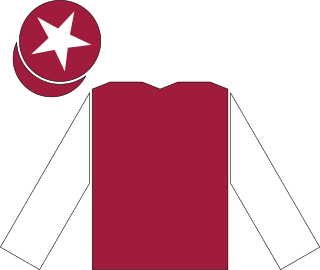
Oh So Sharp (1982–2001) was an Irish-bred, British-trained Thoroughbred racehorse best known for winning the English Fillies' Triple Crown in 1985. In a racing career which lasted from August 1984 until September 1985, she won seven of her nine races, starting favourite on each occasion and never at odds of more than 2/1. She was one of the leading two-year-old fillies of 1984 when she was unbeaten in three races, including the Fillies' Mile. In the following year Oh So Sharp won the 1000 Guineas in record time and then took the Oaks by six lengths before being narrowly beaten in her next two starts in major weight-for-age races. The filly completed the Triple Crown in the St Leger Stakes. She was retired at the end of the season and became a successful broodmare. Oh So Sharp died in 2001 at the age of nineteen.
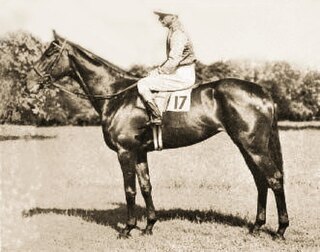
Meld (1952–1977) was a British Thoroughbred racehorse. When she completed the English Fillies Triple Crown by defeating Nucleus in the 1955 St Leger, she was only the fourth filly to do so in the 20th century. She was undefeated as a three-year-old (3YO) and was head of the 3YO Handicap.
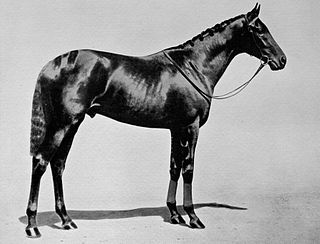
Solario (1922–1945) was a successful British Thoroughbred racehorse and influential sire.

Swynford was a British Thoroughbred racehorse. Bred at the 16th Lord Derby's stud in Lincolnshire, England he was sired by John O'Gaunt, a son of Isinglass, winner of the British Triple Crown in 1893. His dam was Lord Derby's foundation mare and 1896 Epsom Oaks winner Canterbury Pilgrim who also produced Chaucer, the 1927 and 1933 Leading broodmare sire in Great Britain & Ireland.

Crucifix (1837–1857) was an undefeated, Classic Race winning, British-bred Thoroughbred racemare. She was also the dam of three sires who had a great influence on the breed.
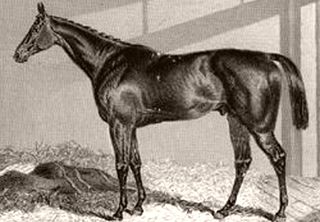
Sweetmeat was a successful English Thoroughbred racehorse that won 16 consecutive races as a three-year-old, including the Doncaster Gold Cup, and was a useful sire of the early 19th century.

Formosa (1865–1881) was a British Thoroughbred racehorse that was the first winner of the English Fillies Triple Crown in addition to running a dead heat with the colt Moslem for the 2,000 Guineas Stakes. Formosa was bred by James Cookson and was foaled in 1865 at his Neasham Hall stud farm. Formosa was sold to William Graham in 1866 and raced her entire three-year racing career under his ownership. After her racing career ended in 1871, she became a broodmare for Graham until his death in 1876. Formosa was exported to France in 1879 and died there in February 1881. While she did not produce offspring that excelled at racing, her daughters that were exported to Germany and New Zealand did produce descendants that were successful racers.

Apology (1871–1888) was a British Thoroughbred racemare who was the third winner of the Fillies' Triple Crown, winning The Oaks, 1,000 Guineas Stakes and St. Leger Stakes in 1874. Apology was bred and owned by the Reverend John William King, the vicar of Ashby de la Launde, whose ownership of the mare caused a minor scandal in the Church of England after Apology won the St. Leger Stakes. King ultimately had to resign his clerical appointments due to the scandal and died shortly thereafter of a chronic illness. Apology raced until she was five years old, winning the Ascot Gold Cup in 1876. She was retired from racing at the end of 1876 to become a broodmare initially for the widow of John King, and then for Clare Vyner. Apology was euthanised in 1888 after an extended illness.

Jest (1910–1921) was a British Thoroughbred racehorse and broodmare, best known for winning two Classics in 1913. The filly won four times from eight races in a track career which lasted from July 1912 until July 1913. As a two-year-old in 1912 she won twice from four starts. On her three-year-old debut she won the 1000 Guineas over one mile at Newmarket and then won the Oaks over one and a half miles at Epsom a month later. She was retired from racing after being beaten in the Coronation Stakes at Royal Ascot and the Nassau Stakes at Goodwood. As a broodmare she produced the 1921 Epsom Derby winner Humorist before dying at the age of eleven.
Oriana was a British Thoroughbred racehorse and broodmare who won the classic Oaks Stakes at Epsom Downs Racecourse in 1810. The Northern-trained filly won the Oaks on her first appearance and finished third against colts in the St Leger Stakes at Doncaster in her only other race that year. She won one of her three races in 1811 and was later exported to become a broodmare in Ireland.

Halfway to Heaven is a retired Irish-bred Thoroughbred racehorse and an active broodmare. After winning one minor race as a two-year-old in 2007, she emerged as one of the leading fillies in Europe the following year, recording Group One successes in the Irish 1,000 Guineas, Nassau Stakes and Sun Chariot Stakes. She was retired from racing at the end of the year having won four of her nine races and became a successful broodmore, producing two Group One-winning daughters.
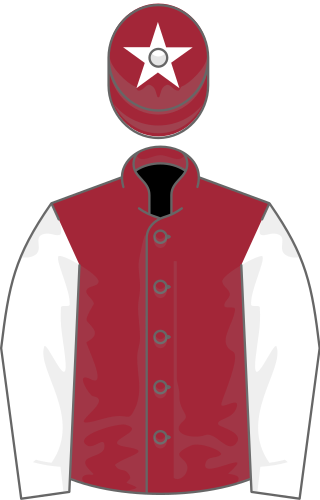
Unite was an Irish-bred, British-trained Thoroughbred racehorse and broodmare best known for winning The Oaks in 1987. She finished second in her only race as a two-year-old and won a minor race in the spring of 1987 before winning the Oaks. She followed up with an easy win in the Irish Oaks but was retired from racing after running poorly in the King George VI and Queen Elizabeth Stakes. She had some success as a broodmare.
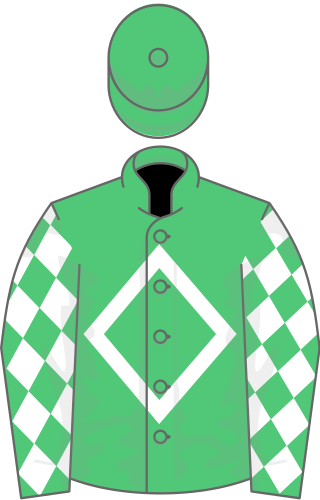
Blue Wind was an Irish Thoroughbred racehorse and broodmare best known for winning the classic Oaks Stakes in 1981. She showed promising form as a two-year-old in 1980 when she won two of her five races including the Silken Glider Stakes. In the following year she finished second in the Irish 1,000 Guineas and then showed her best form when moved up in distance, winning the Oaks by seven lengths and following up in the Irish Oaks a month later. In 1982 she was campaigned in the United States without success. She made no impact as a broodmare.
Why Hurry was a British Thoroughbred racehorse and broodmare, who raced during World War II and was best known for winning the classic Oaks Stakes in 1943. After winning one minor race as a juvenile she finished fifth in the 1000 Guineas before winning the Oaks, run that year on the July Course at Newmarket Racecourse. After finishing unplaced in the St Leger she was retired from racing and had some success as a broodmare.
Masaka was an Irish-bred, British-trained Thoroughbred racehorse and broodmare. She was one of the best fillies of her generation in Europe in 1947 when she won three races including the Queen Mary Stakes and the July Stakes. In the following year she became increasingly temperamental and refused to start on more than one occasion but did show top class form over middle distances, winning the Epsom Oaks and the Irish Oaks.

Snow Marten was a British thoroughbred racehorse and broodmare. She showed promise as a two-year-old in 1914 when she won once and finished second three times from six starts. In the following year she finished unplaced in the 1000 Guineas but then recorded an upset win in the Oaks Stakes. She was placed in wartime substitute races for the Ascot Gold Cup and the St Leger and ended her racing career by finishing third in the Cesarewitch. As a broodmare, she had her biggest influence through her daughter Martha Snow who was exported to the United States.
The Flea, or alternatively Flea, was a British Thoroughbred racehorse notable for winning the 1000 Guineas Stakes in 1849.
References
- ↑ Thoroughbred Heritage: Hyperion Retrieved 2009-10-19
- ↑ Ahnert, Rainer L. (editor in chief), Thoroughbred Breeding of the World, Pozdun Publishing, Germany, 1970
- ↑ ASB: Sun Chariot Retrieved 2010-3-4
- The Complete Encyclopedia of Horse Racing - written by Bill Mooney and George Ennor